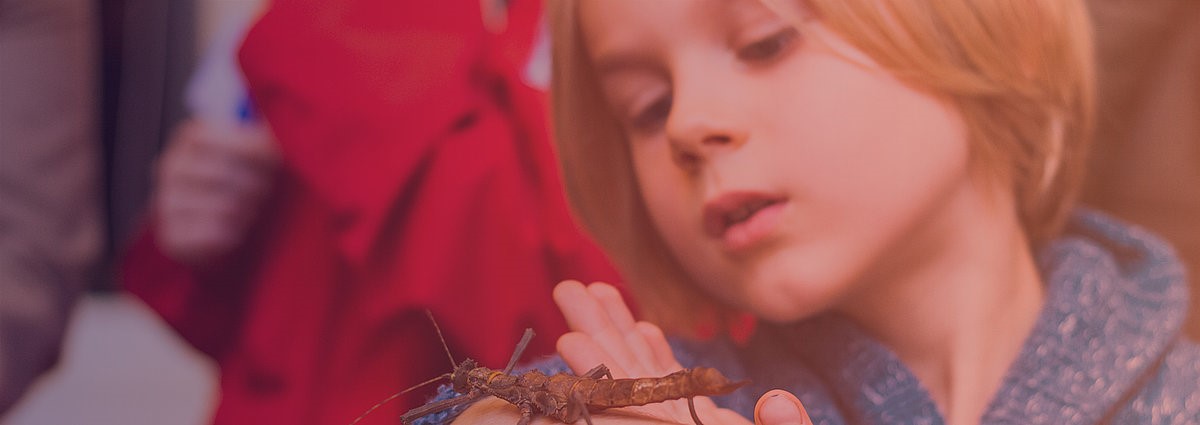
On Friday September 27, concurrently with celebration of the University of Latvia (UL) Centenary at Arena Riga, University researchers, students, schoolchildren, volunteers and other interested people also gathered at the UL Academic Centre at the Stations of Researchers' Night. Visitors took part in a space exploration workshop and watched plants under a microscope, as well as conducted a “black magic” experiment.
This year, the events of Researchers’ Night were particularly vivid and appealing to all ages. The UL Faculty of Chemistry, Biology, Geography and Earth Sciences, Physics, Mathematics and Optometry welcomed visitors at the UL Academic Centre House of Nature, regaling them with information given by nutritionists, offering acquaintance with exotic insects, examination of cells in microscopes, studies of fossils found in Latvia and testing the acuity of their sight in exposition of optical illusions. Alongside the faculties, visitors were also welcomed by institutes – the University of Latvia Livonian Institute introduced the Livonian language and heritage, the Institute of Biology demonstrated bio-testing, whereas the Institute of Chemical Physics explicated radiation and its effects on humans.
Valdis Zuters, a graduate of the University of Latvia and a physics teacher at Tukums Rainis Gymnasium, welcomed visitors in one of the stations at the House of Nature: “My station is related to the way we see the world around us. There are things we cannot see in regular lighting, so I have brought along ultraviolet light. Now we can see more on banknotes, ID cards or passports. I have also set up optical devices – various lenses that both zoom in and out of the picture. They can be used to alter the world around us. And the guys at the next station can show why the sky is blue,” says V. Zuters.
In addition to in-house stations, the University also hosted a variety of guests – Latvian Railway introduced a workshop with SREaMup.lv, where physics experts gave the opportunity to indulge in the magic of experimentation, and French engineer Thomas Peyruse with humanoid robot Poppy.
The University of Latvia House of Science, the UL Institute of Cardiology and Regenerative Medicine showed visitors a 3D printer, the UL Laser Centre introduced the air movement at different temperatures and the UL Institute of Physics demonstrated a variety of experiments with liquid metals and laser light beams to the rhythm of music.
One of the stations gathered the researchers from the Laboratory for Mathematical Modelling of Environmental and Technological Processes, who took visitors’ thermal pictures – portraits, which later were made available via email. Tija Sīle, senior researcher of the laboratory, told us more about the Researchers' Night activities: “Once a year, we open the doors of the House of Science to tell and show the general public much more than our daily work – we are delighted to demonstrate the coolest, most interesting fragments of physics and science. We want to show that physics can be interesting, explosive and creative, but above all, useful. For example, right now I'm at a thermal camera that entertains people with changing colours, but in fact my colleagues use it to implement a thermal audit of buildings”.
Visitors to the House of Science also observed the UL Institute of Solid State Physics experiment of fibre and liquid nitrogen, and the UL Institute of Atomic Physics and Spectroscopy risk assessment of skin melanoma, and implemented mercury measurements. In addition, those interested could view the historical collection of human pathology at the UL Museum of History and speak several languages at the UL Faculty of Humanities station.
Ninth graders Ieva Brice and Mārtiņš Ontužāns took part in the Scientists' Night events as an excursion with their entire class. Both particularly enjoyed the explosive experiment in which hot air was used to create a blast. “At first, I was scared and did not understand what happened, but later the scientist explained that hot air and stone can make a sound,” says Mārtiņš Ontužāns. Ieva also liked the station, where the researchers allowed schoolchildren to handle exotic insects. “It was a little scary at first, I did not think I could take a huge cockroach in my hands, but many of my classmates went before me, and then I got over my fear. I have to say I'm proud now,” the schoolgirl laughs.
The experiences of Researchers’ Night encompassed many more locations of the University: the UL Botanical Garden offered a day trip in the tropics, while the UL Institute of Biology in Salaspils and Pape the visitors could observe the bird and bat ringing or banding, while the Baldone Observatory planetarium hosted an active presentation on space.

 LU konference
LU konference